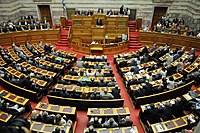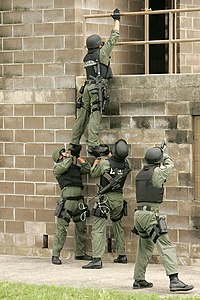Brilliania: Difference between revisions
| Line 199: | Line 199: | ||
===Religion=== | ===Religion=== | ||
A majority of Brillian people affiliate themselves with the native religion [[Marism]], in various degrees. The Federal Bureau for Information's most recent population survey states that 85% of Brilliania adheres to Marism, with 11% being irreligious and 4% adhering to other religions. Within Marism, several different factions exist based off their interpetrations of several letters which more liberal disciples consider as {{wp|Apocrypha|apocryphal}}. These religious factions form a major section in the Brillian societal pillar system. Reformist Marists are the largest faction, with 65% of the religious population going to reformist churches compared to 32% for Orthodox Marists and 3% for Puritan Marists. | {{Pie chart | ||
|thumb = right | |||
|caption = Religions in Brilliania (Adult population) (2015) | |||
|label1 = Reformed Marist Ecse | |||
|value1 = 55.3 | |||
|color1 = Blue | |||
|label2 = Orthodox Ecse's of Brilliania | |||
|value2 = 27.2 | |||
|color2 = Cyan | |||
|label3 = Puritan Association | |||
|value3 = 5.5 | |||
|color3 = RoyalBlue | |||
|label4 = Other and irreligious | |||
|value4 = 12 | |||
|color4 = SmokeWhite | |||
}}A majority of Brillian people affiliate themselves with the native religion [[Marism]], in various degrees. The Federal Bureau for Information's most recent population survey states that 85% of Brilliania adheres to Marism, with 11% being irreligious and 4% adhering to other religions. Within Marism, several different factions exist based off their interpetrations of several letters which more liberal disciples consider as {{wp|Apocrypha|apocryphal}}. These religious factions form a major section in the Brillian societal pillar system. Reformist Marists are the largest faction, with 65% of the religious population going to reformist churches compared to 32% for Orthodox Marists and 3% for Puritan Marists. | |||
There is a small minority of Ditanists in Brilliania, which are loosely organised and do not form part of the pillar system. | There is a small minority of Ditanists in Brilliania, which are loosely organised and do not form part of the pillar system. | ||
[[File:Calvarychurchcharlottenc.jpg|200px|thumb|The Church of the Saviour in Martirien Herria is the largest Reformist Marist church in Brilliania.]] | [[File:Calvarychurchcharlottenc.jpg|200px|thumb|The Church of the Saviour in Martirien Herria is the largest Reformist Marist church in Brilliania.]] | ||
Revision as of 12:48, 19 October 2019
This article is incomplete because it is pending further input from participants, or it is a work-in-progress by one author. Please comment on this article's talk page to share your input, comments and questions. Note: To contribute to this article, you may need to seek help from the author(s) of this page. |
Federal Republic of Brilliania Errepublika Federala Berilinakoren | |
|---|---|
Coat of arms
| |
| Motto: Mantendu egingo dugu We will maintain | |
| Anthem: Ereszerki (Hymn) | |
| Capital | Szaranegertu |
| Largest | Martirien Herria |
| Official languages | Brillian, Iparinan |
| Demonym(s) | Brillian |
| Government | Federal presidential republic |
• Lehendahiritar | Endrike Karagori |
• Bigarendahiritar | Alcai Vikuna |
| Population | |
• 2017 census | 18,792,090 |
| GDP (nominal) | 2017 estimate |
• Total | $508,025,361,060 |
• Per capita | $27,034 |
| Gini (2016) | medium |
| HDI (2017) | very high |
| Currency | Brillian Florrin (EBF) |
| Date format | yyyy-mm-dd |
| Driving side | right |
| ISO 3166 code | EB |
| Internet TLD | .eb |
Brilliania (Brillian: Berilinako), officially the Federal Republic of Brilliania, (Brillian: Errepublika Federala Berilinakoren) is a sovereign state in northeastern Cardia, bordered by the XXX sea and the nations of Dulebia to the east and Finium to the south. Brilliania consists of 6 states, which each enjoy a certain degree of autonomy. It is a federal presidential republic with around 18,8 million inhabitants. Ethnic Brillian people, which speak the isolated Brillian language make up 79% of the population, with a significant minority of Iparinans from the southeastern region of Iparina.
The territory of Brilliania has been populated for several thousand years. The most likely precursors to the modern Brillian people were the Herricsa civilization.
Brilliania was ruled by a monarchy between 964 and 1933, starting when Prince Ganis unified several Brillian towns in the year 964, and ending with the suicide of Prince Ilurdo in 1933. However, the Prince became mostly ceremonial in 1875, with the creation of the first parliament of Brilliania. A limited form of male suffrage was employed, although the parliament was soon rife with corruption. Female suffrage did not exist prior to redemocratisation in 1980.
Brilliania is a developed country with a high-income service-based economy. It ranks very highly in the Human Development Index. Brillian citizens have a high quality of life, assisted by technology investments, low-cost education and a state healthcare system. Despite governmental investments in social security, income inequality is relatively high, with a medium ranking for Gini.
History
Before 964
Early evidence of Brillian civilisation is lacking, due to a late introduction of writing. The earliest proven people to live in modern day Brilliania were the Herricsa civilization, discovered in 1987 and named after the village of Herricsa where major archeological finds relating early Brillian peoples were found. The Herricsa people most likely led a farmer lifestyle, using early farming and foraging skills.
Kingdom of Brilliania (964 - 1933)
In 961, the early Brillian people were united into one kingdom after settling in the area of modern Kostegarba province, led by King Ganis. In the year 972, King Ganis made the traditional religion Marism the state religion. After Ganis died in 1001, his son Hieron came to power. In 1009, Hieron consolidated his power and made Brilliania more in line with the west with the start of a feudal system. He also fought with xxx to take control of southern territories which was a success. In 1016, tribes which currently form the Iparinan people arrived from the xxx of xxx and settled in a short-lived seperate kingdom named the Kingdom of Iparina. King Hieron swiftly conquered Iparinan areas and unified the nation. He died in 1028.
In 1165, king Aurken isued the Diplomatum Iparinicum, granting special priviledges to the Iparinan populace. This is considered to be one of the first autonomy laws.
In 1867, republicans demanded the King to be deposed and a parliament to be created. The king Bikendi did not accept it until he died in 1874, while his reform-minded son Ilurdo accepted the reforms. He issued a decree in which he accepted the demands of the republicans partially; although the Monarchy still existed, it would become less influential and the male populace of Brilliania was allowed to have a parliament. The elections in 1880 marked the start of Brillian democracy. Although the entire male populace was allowed to vote, peasants were often barred from voting due to being illiterate or residing in a constituency where the representative often bribed officers to disallow peasants. Elections were also not secret. The parliament was ineffective, causing general Urdin Ecsebarea to seize power in 1912.
Interbellum
Major political upheavals started to occur after general Urdin Ecsebarea seized power in 1912. His party, the Republic Front, rigged the elections in 1916, 1920, 1924 and 1928 and won absolute majorities each time. This concluded with prince Ilurdo, becoming unhappy with what his nation turned into after the Continental War, committing suicide in 1932.
Republic of Brilliania (1980 - current)
After the end of Ecsebarist rule, Brilliania started its transition to democracy. The ceremonial renaming of the city of Sirizio (named after the second president of the Ecsebarist Brillian State) to Martirien Herria (Town of the Martyrs) marked the symbolic end of Ecsebarism in Brilliania. The first free elections resulted in the religously conservtive Marist People's Appeal winning by a landslide. Rapid introductions of economic changes and constitutional changes including the addition of a directly elected President proved popular, with the Marist People's Appeal raising in popularity until its first downfall in 2000 after the Millenium Revolution protests. The first time an opposition party ever formed a government was in 2006, when the Labour Party formed a majority with the Marist leftist party The Social Marists. In 2010, the MPA regained a majority until 2014, when the ultra-conservative Mentarrine Movement won 97 of 200 seats. The Mentarrine Movement failed to form an agreement with any other party and the entire opposition formed a cabinet 200 days after the election for the sole reason of calling new elections. The snap election in 2015 resulted in a spectacular loss for the Mentarrinists, because they lost all of their seats. The 2019 presidential election marked the second collapse of the Marist People's Appeal, with them coming third in presidential elections and losing nearly three quarters of their parliamentary seats.
Geography
Brilliania is a relatively low-lying country, with parts of the northern coast being below sea level. The southern parts are hillier, including the capital city of Saranegertu. The average national elevation is around 30 metres. The highest point of Brilliania is the 560-metre high Szaran Peak, which is close to Saranegertu. The Szaran Peak is easily climbable and is a popular spot for tourists. Saranegertu itself is one of the highest-elevated cities in Brilliania, being around 350 metres high.
Climate
Environment
Politics and Government
The Republic of Brilliania is administered as a federal presidential republic governed by the laws defined in the Fourth Constitution of the Republic, which was signed in 2002. The parliament of Brilliania is the bicameral Parliament, consisting of the lower Second Muntaia and the upper First Muntaia. The highest role in Brillian politics is the Lehendahiritar, which is elected directly by the electorate using the two-round method. The term Lehendahiritar means First Citizen. The current Lehendahiritar is Endrike Karagori, representing the Communist Party. He was inaugurated on 20 August 2019.
Parliament
The National Muntaia is the bicameral legislature of the Republic of Brilliania. It consists of two chambers, the 200-member Second Muntaia and the 75-member First Muntaia. The First Citizen is allowed to make law proposals and parliamentary motions, the latter only if they are physically in the Parliament.
20 MPs, or the First Citizen alone, may propose a parliamentary motion to expel a member if he breaks parliamentary protocol.
Since 2005, the parliamentary rules have included provisions for a weekly parliamentary question session for the First Citizen.
Parties
Since the fall of Echebarism, Brilliania has a multi-party system. The most recent legislative election occured on 1 September 2019.
Law and judicial system
The judicial system in Brilliania is based off civil law and religious law. There are three kinds of courts: district courts, regional high courts and the Supreme Court (Kuria). The Kuria is based in Saranegertu.
Law enforcement in Brilliania is operated by the Ercainca, which carries out all major police duties such as investigation, patrol activity, traffic policing and border control. The Ercainca is led by the Federal Commissioner of Law Enforcement, supervized by the Interior Minister. It is divided into regional and city divisions. The elite force of the Ercainca, the semi-militarized Jendarme, is used for riot control and critical incidents. Officially, the Jendarme is a wing of the Brillian Army.
Military
The Brillian army has suffered from lack of budget in recent years; affecting its purchase of materials and causing them to still use outdated equipment. The Army has 4 divisions; the Land Forces, Navy, Air Force and the Jendarme (the elite unit of the Ercainca).
Foreign Relations
Economy
Energy
Industry
Infrastructure
Transport
Brilliania has a highly developed network of road, train, air and sea connections. Martirien Heria and Aingeruak (Angyalok) are major hubs for train travel. All trains are owned by the state-owned Trenfed (Trenbide Federala; Federal Rail) company. Trenfed is also responsible for operation of train stations.
Brilliania has arond 3500 kilometres of highways (autobidea), mostly connecting between cities. There are also 5000 kilometres of provincial roads (autobidea estatuak).
Demographics
According to the most recent national census, a total of around 18.8 million people live in the Republic of Brilliania. Most citizens live in Kostegarba, Iparina and Ocaurte provinces. The largest city is Martirien Heria, which houses around 2 million people and was the former capital of Brilliania until 1995. The capital city is Szaranegertu.
Brilliania is considered a relatively homogenous nation, with the most major groups being the Brillians and the Iparinans. Other minorites include xxx, xxx and xxx.
Education
Education in Brilliania consists almost fully of public education, with standards being created by the Ministry of Education. Preschool is optional but highly recommended, and 97% of Brillian children between the ages of 3 and 6 attend preschool. Schooling generally starts at age 7 and is mandatory until the age of 17. At the age of 12, students must do the EPA exam which decides which of the 3 levels of secundary education a child will go to.
The three levels of secondary education in Brilliania are called Lower Secondary, Middle Secondary and Higher Secondary. Lower Secondary is a form of vocational education and prepares a student for future work. It takes 3 years and exams are performed at the age of 15.
Middle Secondary is a form of education mostly meant for preparation for future education or work. It takes 4 years and exams are performed at the age of 16.
Higher Secondary is the most prestigious form of secondary education. It prepares a student for the Matura and university-level tertiary education. It takes 5 years. Higher Secondary students are given the Matura at the age of 17.
Religion
Religions in Brilliania (Adult population) (2015)
A majority of Brillian people affiliate themselves with the native religion Marism, in various degrees. The Federal Bureau for Information's most recent population survey states that 85% of Brilliania adheres to Marism, with 11% being irreligious and 4% adhering to other religions. Within Marism, several different factions exist based off their interpetrations of several letters which more liberal disciples consider as apocryphal. These religious factions form a major section in the Brillian societal pillar system. Reformist Marists are the largest faction, with 65% of the religious population going to reformist churches compared to 32% for Orthodox Marists and 3% for Puritan Marists.
There is a small minority of Ditanists in Brilliania, which are loosely organised and do not form part of the pillar system.
Culture
Music
Brillian music mostly consists of traditional folk music and the classical music of XXX and XXX. Its folk music comprises a major part in its historical development of music.
In the early 1960's, Brillian alternative music started developing as a form of youth rebellion. Bands such as Indarre and Bonba, the latter mixing domestic music with influences from reggae and ska, were popular underground bands. The end of communism started a boom in alternative music, although most bands kept their aesthetic from the old times.
Foreign music is very uncommon, as many foreign pop artists have been declared persona non grata.
Another revival in modern music started in the late 2010's after 78 persona non grata degrees against artists were withdrawn, causing a rapid internationalisation of Brillian music.
Brilliania has a large metal scene, with the Fallen Angel Festival in Aingeruak annually drawing crowds of up to 75.000 fans. Major domestic metal bands include AMB (Another Metal Band), Gonoszsága, REKIN and Gorrotoak.
A popular form of Brillian folk music are simple songs often about problems in life such as the death of relatives and loneliness. These songs are often known as Bizicua kantua (Life songs) or Dolu kantua (Mourning songs). These songs use simple language and often use instruments such as accordeons and guitars. Saroi Musaurieta and his son Tirteo Musaurieta are pioneers in bizicua kantua, with Saroi being Brilliania's most famous singer until his death in 2007 from alcohol-induced liver failure. His funeral still is Brilliania's most watched television event ever, with 8,3 million reportedly watching Saroi Musaurieta's funeral and 43.000 attending live, with the huge attendance causing a stampede.
Cuisine
Cuisine is a big part of the Brillian culture, with cooking being regarded as a communal event especially at special occasions. Brillian cuisine is influenced by its history and geography, especially the historical releations with Veleaz. In the north, fish dishes are widespread, while in the south meat is preferred. Traditional dishes are often marked by their simplicity, with most dishes consisting of less than 5 ingredients.
In Iparina, the XXX influence is most visibly in the prominence of paprika. Most dishes from Iparina are stewed, with beef being the most popular meat used. Nationwide-renowned Brillian dishes are erreta and kullas. Both are forms of beef stew featuring paprika as a key ingredient.
A common occurrence in Brilliania are the so-called csoko, which are closed gastronomical societies for men. csokos doubled as speakeasies during Ecsebarist rule. Most csokos have their own constitutions featuring rules the members must agree to. They are very common institutions. Most csokos are very conservative - traditional clothing is required and women are banned from entering because cooking is often regarded as a male activity in Brilliania. In recent years the so-called csoko soziala, or social csoko, have been started in most major cities. Social csokos allow women, and have liberal dress codes. Csokos are also a common place for political debates.








